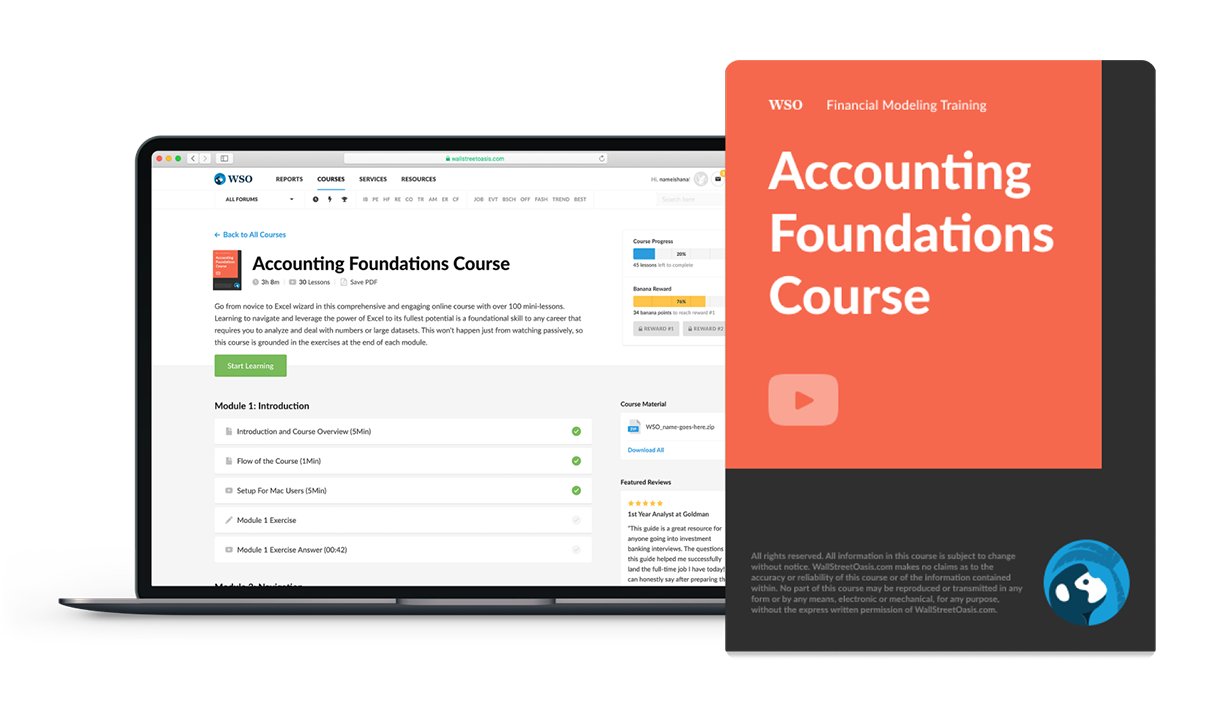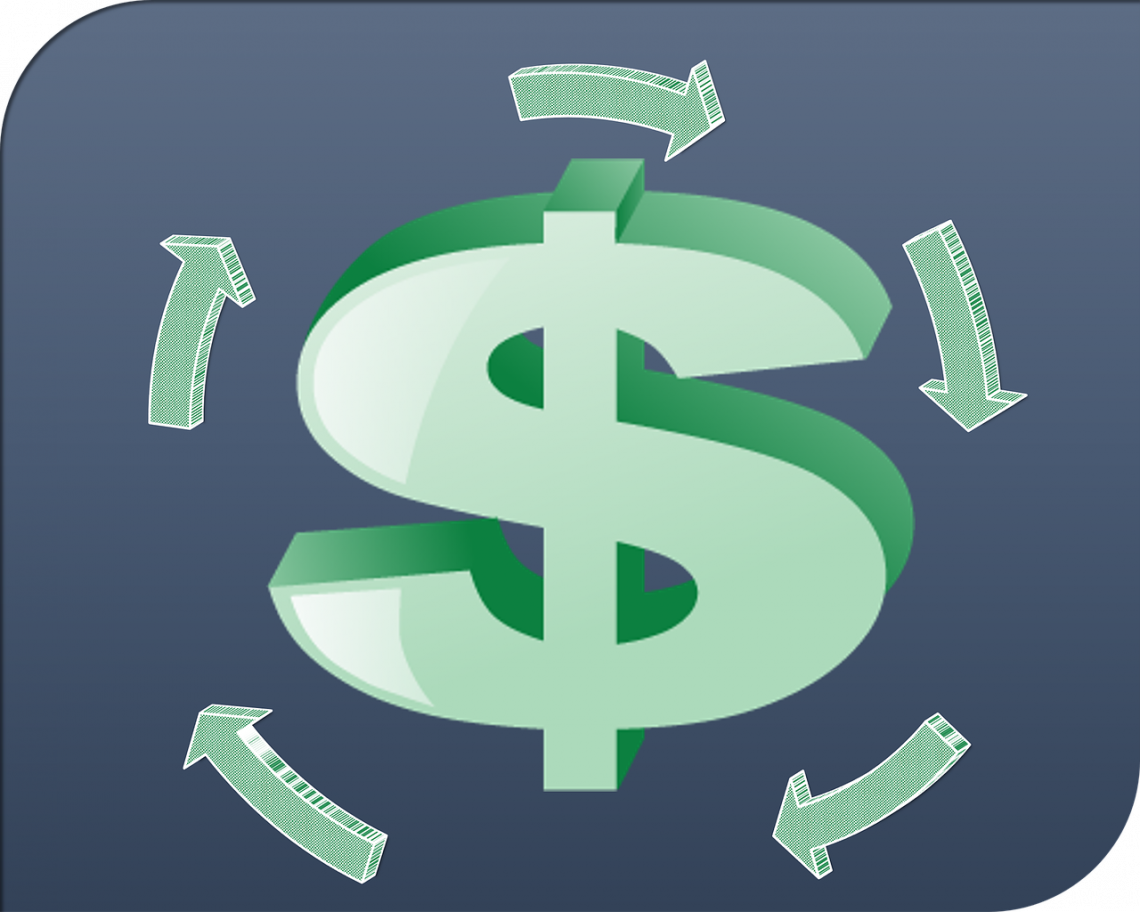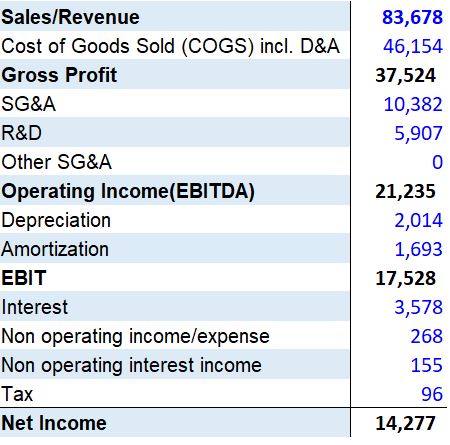
EBIT
Earnings Before Interest and Taxes
It stands for Earnings Before Interest and Taxes and is an item on a company's income statement. It is also called operating income or operating profit. It's found by deducting all operating expenses (production and non-production costs) from revenue.

It measures how much profit a company has generated before accounting for interest expenses and taxes. This profitability metric is monitored by analysts and investors alike as it shows how well a company is managed.
Earnings before interest and taxes (EBIT) formula
This profitability metric can be calculated in different ways. For example, it can be obtained from the company's net income, or bottom line as it is also known, or its Earnings Before Interest, Tax, Depreciation, and Amortization, also known as EBITDA.
Additionally, gross profit, which equals total sales revenue minus the cost of goods sold (COGS), can also be used to calculate it.
If you use net income to calculate it, you have to add back interest, taxes, and depreciation. To calculate EBIT, you will need to know:
- Gross income
- Net income
- Interest expenses
- Taxes
- Depreciation
The different methods for calculating it are as follows:
EBIT = Net Income + Interest + Tax
EBIT = EBITDA - Depreciation - Amortization
EBIT = Gross Profit - SG&A + Depreciation - Interest
The above methods take into account only the income and expenses from the business's core operations. Often, Earnings Before Interest and Taxes can include non-recurring, one-time expenses, such as legal fees, restructuring costs, stock-based compensation, and income and expenses from non-operating profit.
Non-operating income is not associated with the company's day-to-day dealings. Instead, it relates to income from investments, such as dividends, profit, or loss, including foreign exchange (FX).
In addition, interest income can be included; however, interest expense is always excluded from the calculation.
From this perspective, it represents a more detailed operating profit metric as it can include both operating and non-operating income and expenses.
However, as EBIT isn't part of the Generally Accepted Accounting Principles or GAAP, it can differ for different companies, depending on what the management wants to include in its calculation.

Everything You Need To Build Your Accounting Skills
To Help You Thrive in the Most Flexible Job in the World.
EBIT vs. other line items on the income statement
It appears near the bottom of the income statement and is one of the final subtotals before net income.
As a profit and management efficiency metric, the Earnings Before Interest and Taxes have a relation to other items included on the income statement. They are codependent.
The interrelation of EBIT with other measures such as EBITDA on the income statement is illustrated below:
Revenue
(-) Direct expenses
Gross profit
(-) Indirect operating expenses excluding depreciation and amortization
EBITDA (Earnings Before Interest, Tax, Depreciation, and Amortization)
(-) Depreciation and amortization
EBIT (Earnings Before Interest and Taxes)
(-) Interest
(-) Taxes
Net income
The following sections present the differences between other income statement elements.
EBIT and Net Income
Net income is the bottom line of a company's financial statement and the only line in an income statement that gives you a sense of profitability. It tells us how much money the business made or lost in a given period.
On the other hand, EBIT is an indicator that reflects how much money your business has left over after paying for operating expenses, including production and non-production costs.
Non-operating expenses could also be included in the calculation. It's important to note that Earnings Before Interest and Taxes doesn't consider taxes and doesn't reflect what the company owes.

EBIT and Taxes
Earnings Before Interest and Taxes have their merits. However, because it's not adjusted for taxes, it could present an incomplete view of the company's financial situation.
It could be significantly affected by the firm's capital structure, especially when comparing it to one that has a much different capital structure. For example, similar companies with higher debt levels may end up with a higher profit as interest is a tax-deductible expense.
Earnings Before Interest and Taxes tells only half of the story when you take taxes into account. First, you need to know how much of your operating income is taxable and the effective tax rate.
So, what to do if we want to evaluate EBIT but don't want to include the effect of taxes?
One solution is to use EBT or Earnings Before Taxes. EBT is calculated by subtracting all expenses and interest from sales revenue before calculating taxes. It gives us a better idea of how much money the business can keep in its pockets before paying taxes on its profits.
It is particularly helpful for investors looking at companies in various tax jurisdictions and wanting to analyze their performance without prejudice to the impact of taxes.
EBIT and Debt
Earnings Before Interest and Taxes is one of the most important numbers in a company's financial statements to debtholders because it shows how much profit is available for them.
The higher the Earnings Before Interest and Taxes, the higher the company's ability to cover its debt obligations, such as interest and capital repayments, and raise additional debt and lower rates.
Like EBITDA, EBIT considers the capital provided by debtholders to the company and hence is a much more reliable way to measure its financial health.
It can also be used as a quick proxy in coverage ratios instead of operating cash flows. When adjusted for changes in net working capital balances, Earnings Before Interest and Taxes can serve as a proxy for cash flow from operations.
Interest payments on outstanding debt are then deducted from operating cash flows to arrive at the total cash flow to equity holders.
If a company has a positive (+) EBIT but a negative (-) EBT, it could be a sign that it is not following an optimal capital structure. In this particular case, the company is probably over-leveraged to the point that the debt raised is the reason for incurring losses.
EBIT and Free Cash Flow (FCF)
Free cash flow is the amount of cash generated by a company's core operations and can be calculated as: Earnings Before Interest and Taxes minus (-) the fixed and working capital expenditure. It represents how much cash a company has on hand to invest in new projects or return to shareholders through dividends or buybacks.
It is essential to compare the free cash flow with other similar-sized firms operating in the same industry. Companies with higher margins will typically have higher FCF.
The difference between these two concepts is that the former can be influenced by non-cash expenses like depreciation and amortization. At the same time, the latter only considers cash-based expenses.
FCF is used more often for valuation, especially as part of DCF or multiples analysis, as it is less prone to manipulation by accounting gimmicks.

Example of eBIT
To better understand EBIT, we'll take a hypothetical example below. Let's assume that company A has the following financial data expressed in millions.

Following the calculations,
EBIT = Sales - Operating and non-operating expenses
This is the top-down approach.
If Earnings Before Interest and Taxes are calculated using the bottom-up method, then the calculation will read:
EBIT = Net Income + Tax - Non operating interest income - Non operating income/expense + Interest
Uses of Earnings Before Interest and Taxes
The operating profit is an essential metric for the company and investors. It is used as a:
1. Method of comparison
The operating profit compares a company's performance between different periods and relative to other businesses in the same industry.
The return on total assets (ROTA) ratio enables analysts and investors to determine how much profit a company's assets make. The ratio is as follows:
ROTA = EBIT / Total Assets
The use of Earnings Before Interest and Taxes helps to understand the profits generated by the assets without the impact of interest expenses and taxes.
The higher the ratio, the more money a company makes from its assets. It also signals that the business uses its assets efficiently and optimally.
2. Relative valuation technique
The EV/EBIT multiples ratio, which compares the enterprise value to the operating income, is used by investors to understand if the stock is over or underpriced. This ratio also informs investors about the earnings yield of the company.
A low EV/EBIT ratio can signal that a stock is undervalued, while a high ratio typically means that the company is overvalued. The following readings of the ratio helps to understand the financial situation of a company:
- A value of or around 0 - It means that the company has no profits and will have a difficult time attracting investors.
- A value of 1 or more - It means that the company is profitable.
- A value of 2 or more - It indicates that the firm can be overvalued.
- Proxy for unlevered free cash flow (FCF)
Earnings Before Interest and Taxes can be a good proxy for free cash flow for mature companies with consistent capital expenditure (CapEx), such as automobile, oil, energy, utilities, and transportation industries.
Unlevered FCF is the cash flow available to a company before paying its obligations. You can build a financial model in Excel and calculate it using the following formula:
FF = EBIT*(1-T) + D&A - ΔNWC - CapEx
where,
FCF: Free cash flow
T: Average Tax rate
D&A: Depreciation and amortization
ΔNWC: Change in net working capital
CapEx: Capital expenditure
Normalization of earnings
Earnings Before Interest and Taxes allows analysts and investors to compare companies in the same sector but have different capital structures and debt interest schedules.

What Is EBIT Margin?
The operating margin ratio tells investors and analysts how much-operating profit is generated for every dollar of revenue.
Higher margins usually send positive signals to the market, notably that the business is managed efficiently and effectively.
If the operating profit margin is negative, it means that the company doesn't have control over its costs. In other terms, it spends more than it makes.
The margin can be compared to the firm's past operating margins, the firm's current net profit margin, and gross margin or the margins of other similar firms operating in the same industry.
It is expressed as follows:
EBIT margin = EBIT / Revenue
Operating profit margins vary depending on the company and the industry in which it operates. For example, the construction sector tends to have low margins, around 1.5% - 2%, while banks can easily report margins higher than 10% - 15%.
For example, company A reports sales of $700,000 and operating income of $250,000 and company B reports $1m and $400,000 respectively. Based on this, the profit margin for company A is 35.7% ($250,000 / $700,000) and for company B it is 40% ($400,000 / $1,000,000).
Company B, in this case, is in a better financial position, and it makes more profit per dollar of revenue.

EBIT vs. EBITDA
Both are profitability metrics that allow comparison between companies and can be used as proxies for operating cash flows. They have similarities and differences that are outlined below.
1.Similarities
- Valuation multiples
EBITDA, which stands for Earnings Before Interest, Tax, Depreciation, and Amortization, is another profitability metric used in comparing and valuing companies.
Similar to Earnings Before Interest and Taxes, EBITDA is used in relation to enterprise value (EV), a metric that ignores the company's capital structure, to obtain valuation multiples.
A high EV / EBITDA ratio signals that the company can be overvalued. Conversely, a low EV / EBITDA ratio is typically associated with a firm being undervalued, which can present a good buying opportunity.
- Cash availability
The two ratios help to measure the operating performance of a business. They are the cash flows available to debt holders, shareholders, and the government since these two metrics are not adjusted for taxes and interest on the debt.
- Non-GAAP metrics
Both metrics are non-GAAP metrics, and as such, there isn't an established method for calculating them. Companies can decide what to include or exclude from the calculation, including income and expenses from non-core operating activities.
2. Differences
- Depreciation and amortization adjustment
The main difference between these two metrics is that EBIT includes depreciation and amortization, whereas EBITDA doesn't.
Some investors, like Warren Buffet, are adamant about using EBITDA as it doesn't reflect the capital structure of a business, changes in working capital, and depreciation, which can be a significant non-cash expense for capital-intensive sectors such as manufacturing, utilities, oil, and gas, among others.
As fixed assets have a certain lifespan, not considering the fact that these assets wear out and need to be replaced can be a flawed methodology.
- Capital expenditure (CapEx) considerations
Another difference between these two ratios is the adjustment for capital expenditure (CapEx).
Earnings Before Interest and Taxes partially includes capital expenditure as this is the cash flow obtained after subtracting depreciation.
On the other hand, EBITDA doesn't make provisions for CapEx as this is the cash flow available before deducting depreciation.
- Rent and lease expenses
Moreover, depending on what accounting methodology is used - GAAP or IFRS - the accounting of rent leases will be different for the two valuation methods.
Under GAAP, the full rent expenses are deducted from both methods. Under IFRS, however, rent is capitalized, and then the depreciation on renting the capitalized asset is deducted (-) from EBIT while it's excluded from EBITDA.

Advantages of eBIT
The main advantages of Earnings Before Interest and Taxes are summarized below.
- Metric of profitability: It shows whether a business makes enough money to keep its operations going, pay its debt and generate profits.
- Indicator of operating performance
- Straightforward comparison metric: It excludes taxes and debt interest; it makes it easy to compare companies that may have different interest and tax rates, depending on their geographical location.
- Depreciation and amortization adjusted: Earnings Before Interest and Taxes considers depreciation and amortization of assets. This is useful because assets will have to be replaced, and as such, taking into account D&A provides a more accurate representation of the company's finances.
Disadvantages of EBIT
In reference to the calculation of EBIT the included deduction of depreciation and amortization and the exclusion of interest may create challenges for the comparability of the metric.
- High depreciation: A company with many fixed assets will have higher depreciation than a business with fewer fixed assets. Companies in the manufacturing, oil and gas, mining, and commercial real estate industries usually have many fixed assets; hence they will have more depreciation costs. The higher depreciation expenses will impact EBIT.
- Interest payment: Highly leveraged firms will pay more interest on the debt. As interest is excluded from Earnings Before Interest and Taxes, this may present inexact results that mislead investors. As the capital structure is not considered in it, a high amount of debt may cause concern if the firm doesn't generate enough money to cover its obligations.
- Discrepancies in tax jurisdictions: The exclusion of taxes from it may impact the viable comparison of the firms in the same industry but in different tax jurisdictions. If an investor compares firm A located in Bahrain, a low tax country, and firm B, with tax residency in Brazil, a high corporate tax country, then Earnings Before Interest and Taxes may not be that useful. Other metrics and ratios should complement it.

Everything You Need To Master Excel Modeling
To Help You Thrive in the Most Prestigious Jobs on Wall Street.
Free Resources
To continue learning and advancing your career, check out these additional helpful WSO resources:


or Want to Sign up with your social account?